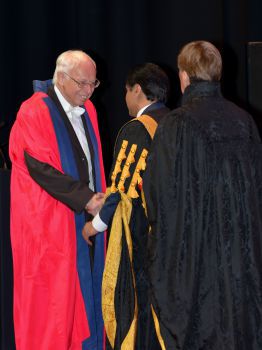Chemistry Nobel laureate is “a great mentor” says top Sussex scientist
Scientists at the University of Sussex have praised the achievements of one of the new Nobel Prize-winners for Chemistry who received an honorary degree from the University in 2013.
 Dr Tomas Lindahl, who is one of the 2015 Nobel Prize for Chemistry recipients, received an honorary degree from the University of Sussex in 2013.
Dr Tomas Lindahl, who is one of the 2015 Nobel Prize for Chemistry recipients, received an honorary degree from the University of Sussex in 2013.
Dr Tomas Lindahl, who shares the 2015 prize with two others for “mechanistic studies of DNA repair” - one of the fundamental processes in the study of cancer, was described by Head of Life Sciences Professor Laurence Pearl as “a great mentor to me”.
In presenting him with the honorary degree, Doctor of the University, two years ago, Professor Pearl said: “Tomas is an inspirational scientist, who combines modesty with passion, and a great enthusiasm for his own science with a genuine commitment to developing the scientific careers of others. These are the attributes of a truly outstanding scientist and leader of scientific research.”
During the same ceremony, Dr Lindahl spoke highly of the University’s research and its scientists in the Cell Mutation Unit (and later the Genome Damage and Stability Centre), many of whom he had met and grown to admire during his own career.
He said: “The University of Sussex has emerged as one of the leading research institutions in my field of research. It is a great success. I can’t think of a better lab in Britain than here.”
He described Professor Alan Lehmann, whom he met more than thirty years ago when he first came to the UK, as “a particularly clever scientist who has had an outstanding career in the meantime and is internationally recognised in the DNA repair field”.
He also paid tribute to Sussex professors Penny Jeggo (“I have followed her work with great admiration”), Keith Caldecott(“in arguments he was right and I was wrong”) and Tony Carr (“one of the brightest scientists anywhere”).
And he remembered being invited by Laurence Pearl, then a young scientist at University College London, to look at a model of an enzyme that Dr Lindahl and his team had been working on.
“He spent a couple of hours explaining how his 3d model actually provided a solution to some of the research problems that we had been worrying about. He did this in a very informed and gracious way.”
Swedish-born Dr Lindahl shares the 2015 Nobel Prize for Chemistry with Paul Modrich and Aziz Sancar. Dr Lindahl’s work has involved the discovery that DNA is susceptible to a wide range of chemical reactions that can take place under normal physiological conditions and alter the chemistry of the DNA bases, changing the information they encode and thereby causing genetic mutations.
